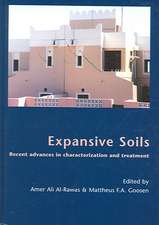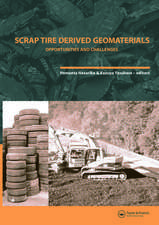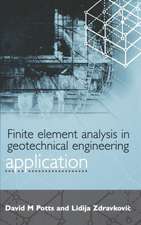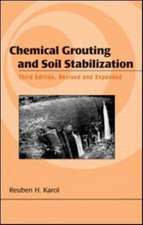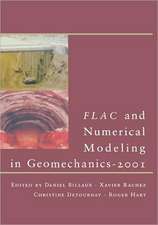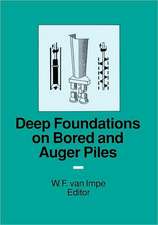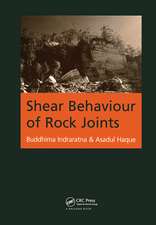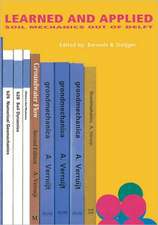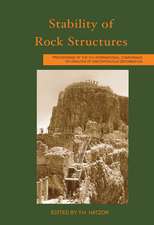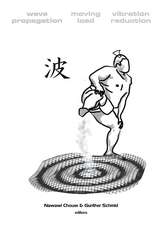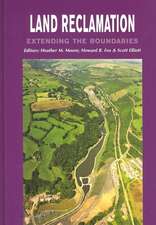Soil Mechanics Fundamentals and Applications
Autor Isao Ishibashi, Hemanta Hazarikaen Limba Engleză Hardback – 24 mar 2015
How Does Soil Behave and Why Does It Behave That Way?
Soil Mechanics Fundamentals and Applications, Second Edition effectively explores the nature of soil, explains the principles of soil mechanics, and examines soil as an engineering material. This latest edition includes all the fundamental concepts of soil mechanics, as well as an introduction to foundation engineering, including coverage of site exploration, shallow and deep foundation design, and slope stability. It presents the material in a systematic, step-by-step manner, and contains numerous problems, examples, and solutions.
New to the Second Edition:
The revised text expands the contents to include an introductory foundation engineering section to make the book cover the full range of geotechnical engineering. The book includes three new chapters: Site Exploration, Deep Foundations, and Slope Stability.
This text:
- Provides an introductory chapter on soil mechanics
- Explores the origin and description of soils and discusses soil shapes and gradations
- Presents the unique characteristics of clays
- Details soil classifications by the Unified Soil Classification System (also ASTM) and by the American Association of State Highway and Transportation Officials (AASHTO)
- Highlights laboratory and field compaction techniques, including field specification and density testing, and the CBR (California Bearing Ratio) method
- Discusses the flow of water through soils, defining hydraulic heads, as well as the two-dimensional flow net technique and a systematic approach to compute boundary water pressures
- Examines the concept of effective stress and its applications to various soil mechanics problems
- Explores stress increments in a soil mass due to various types of footing load on the ground
- Presents Terzaghi s one-dimensional consolidation theory and its applications
- Covers Mohr s circle from geotechnical perspectives with use of the pole, which is utilized in chapters relating to shear strength and lateral earth pressure
- Addresses the shear strength of soils, failure criteria, and laboratory as well as field shear strength determination techniques
- Evaluates at-rest earth pressure and the classic Rankine and Coulomb active and passive pressure theories and present critical review of those methods
- Reviews introductory foundation engineering and site exploration
- Describes the bearing capacity theory and, as an application, the shallow foundation design procedure
- Covers deep and shallow foundation design procedures
- Explains slope stability problems and remediation procedures, and more
Soil Mechanics Fundamentals and Applications, Second Edition is a concise and thorough text that explains soil s fundamental behavior and its applications to foundation designs and slope stability problems and incorporates basic engineering science knowledge with engineering practices and practical applications.
"
Preț: 557.90 lei
Preț vechi: 804.45 lei
-31% Nou
106.77€ • 111.06$ • 88.14£
Carte tipărită la comandă
Livrare economică 15-29 aprilie
Specificații
ISBN-10: 1482250411
Pagini: 432
Ilustrații: 365 black & white illustrations, 99 black & white tables
Dimensiuni: 156 x 234 x 28 mm
Greutate: 0.75 kg
Ediția:Revised
Editura: CRC Press
Colecția CRC Press
Cuprins
Notă biografică
Dr. Hemanta Hazarika is a professor in the Department of Civil Engineering, Kyushu University, Fukuoka, Japan. He obtained his bachelor of technology degree in civil engineering from the Indian Institute of Technology (IIT), Madras, India, and his PhD in geotechnical engineering from Nagoya University, Japan. He also worked as a practicing engineer in industry as well as a researcher in the public sector research institute of Japan. Professor Hazarika has more than 130 technical publications in reputed international journals, proceedings of international conferences, and symposia, including contributed chapters in several books. He is also the editor of two books in his research fields.
Recenzii
—Charles E. Pierce, Ph.D, The University of South Carolina, Columbia, USA
"In summary, the level of explanation is much richer than most undergrad level books in use and … Many soil mechanics text book authors do not know where to draw the line between mechanics and engineering and they load up the texts with too many foundation related information"
—Hirroshan Hettiarahchi, United Nations University
"This is a good soil mechanics book. It is written very concisely and straightforwardly, in a way students can teach themselves. It covers most of the common topics in the areas of Soil Mechanics and Geotechnical Engineering practice. It is a good textbook for a Civil Engineering Program where students only take one course in geotechnical engineering."
—Jay X. Wang, Louisiana Tech University
Descriere
How Does Soil Behave and Why Does It Behave That Way?
Soil Mechanics Fundamentals and Applications, Second Edition effectively explores the nature of soil, explains the principles of soil mechanics, and examines soil as an engineering material. This latest edition includes all the fundamental concepts of soil mechanics, as well as an introduction to foundation engineering, including coverage of site exploration, shallow and deep foundation design, and slope stability. It presents the material in a systematic, step-by-step manner, and contains numerous problems, examples, and solutions.
New to the Second Edition:
The revised text expands the contents to include an introductory foundation engineering section to make the book cover the full range of geotechnical engineering. The book includes three new chapters: Site Exploration, Deep Foundations, and Slope Stability.
This text:
- Provides an introductory chapter on soil mechanics
- Explores the origin and description of soils and discusses soil shapes and gradations
- Presents the unique characteristics of clays
- Details soil classifications by the Unified Soil Classification System (also ASTM) and by the American Association of State Highway and Transportation Officials (AASHTO)
- Highlights laboratory and field compaction techniques, including field specification and density testing, and the CBR (California Bearing Ratio) method
- Discusses the flow of water through soils, defining hydraulic heads, as well as the two-dimensional flow net technique and a systematic approach to compute boundary water pressures
- Examines the concept of effective stress and its applications to various soil mechanics problems
- Explores stress increments in a soil mass due to various types of footing load on the ground
- Presents Terzaghi s one-dimensional consolidation theory and its applications
- Covers Mohr s circle from geotechnical perspectives with use of the pole, which is utilized in chapters relating to shear strength and lateral earth pressure
- Addresses the shear strength of soils, failure criteria, and laboratory as well as field shear strength determination techniques
- Evaluates at-rest earth pressure and the classic Rankine and Coulomb active and passive pressure theories and present critical review of those methods
- Reviews introductory foundation engineering and site exploration
- Describes the bearing capacity theory and, as an application, the shallow foundation design procedure
- Covers deep and shallow foundation design procedures
- Explains slope stability problems and remediation procedures, and more
Soil Mechanics Fundamentals and Applications, Second Edition is a concise and thorough text that explains soil s fundamental behavior and its applications to foundation designs and slope stability problems and incorporates basic engineering science knowledge with engineering practices and practical applications.
"

